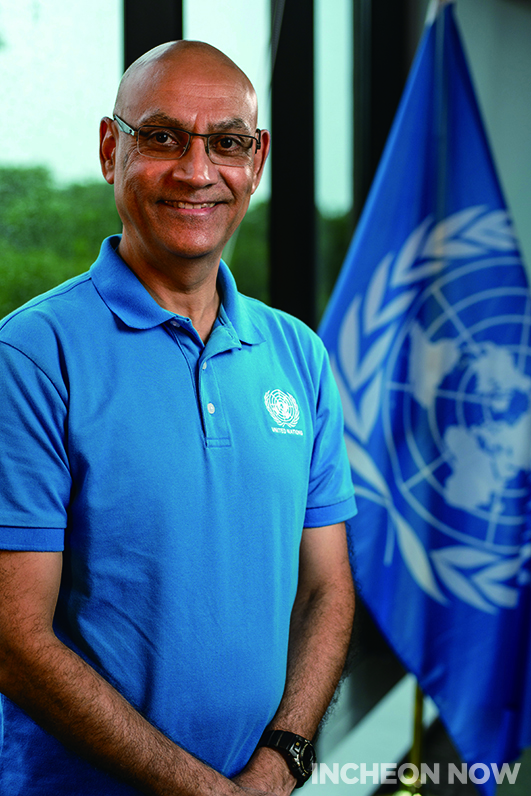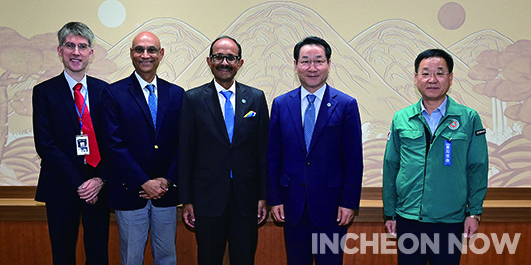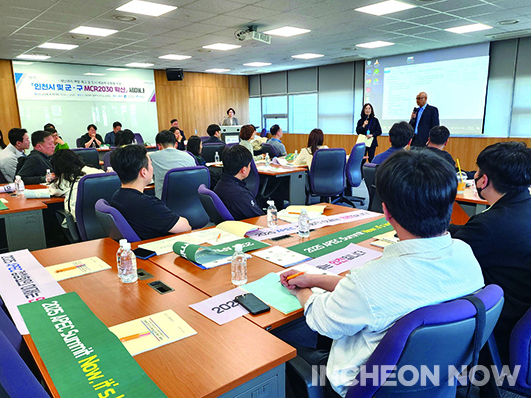[Beyond Borders]
MANAGING DISASTERS PREEMPTIVELY THROUGH EDUCATION AND COOPERATION
There are many conditions for a happy life, but safety is essential. In Incheon, there is an organization that aims for safety and strives to reduce disaster damages in Northeast Asia and create a resilient society. We met with Sanjaya Bhatia, the Head of the United Nations Office for Disaster Risk Reduction Office for Northeast Asia, and heard his story.

Interviewee.
Sanjaya Bhatia
the Head of the Office of the United Nations Office for Disaster Risk Reduction (UNDRR) Office for Northeast Asia (ONEA)
Q. We are <Incheon Now>, Incheon’s English newsletter, and thank you for giving us an interview. You are currently the Head of the Office of the United Nations Office for Disaster Risk Reduction Office for Northeast Asia. Please give us a brief introduction to your organization.
A. The United Nations Office for Disaster Risk Reduction (UNDRR) is the global intergovernmental organization tasked with helping decision-makers to better understand and act on disaster risk. UNDRR is part of the UN Secretariat and is headed by the Special Representative of the Secretary-General for Disaster Risk Reduction. Through a network of regional and global offices, UNDRR staff “provide leadership and support to accelerate global efforts in disaster risk reduction to achieve inclusive sustainable development and the goal of the Sendai Framework [for Disaster Risk Reduction].”
The UNDRR Office of Northeast Asia (ONEA) and Global Education and Training Institute (GETI) were established in 2010 in Incheon City under a partnership that included the Government of the Republic of Korea, Incheon Metropolitan City, and UNDRR. These two distinct yet closely linked offices work to establish disaster-resilient societies by advancing DRR professionalization and capacity building worldwide and, within the Northeast Asia region, promoting societal resilience through partnership building, technical support, and advocacy.
Since foundation ONEA & GETI has engaged with more than 119,000 people Including:
◆ More than 29,150 through training and workshops
◆ More than 26,600 through events
◆ More than 49,500 through the Korea School Safety Program
◆ More than 13,900 through online webinars
Q. We wonder which role the Office for Northeast Asia plays in Songdo, Incheon.
A. ONEA works in close coordination with the Trilateral Cooperation Secretariat (TCS), the Citizens’ Coalition for Safety (CCS), local universities, and other partners, to advance DRR capacity inside Korea. This includes the highly successful Korean School Safety Programme (KSSP), the Making Cities Resilient (MCR2030) initiative, and the newly launched International Disaster Resilience Leaders Forum (IDRLF; 2022, 2023, and 2024). The Korean Ministry of the Interior and Safety (MOIS) as well as the Incheon Metropolitan City government closely partner with ONEA to facilitate these programs. In fact, since 2011, UNDRR ONEA & GETI trained 2,445 professionals in Korea. Among ONEA & GETI’s various programs, the singlelargest participant audience of Korean nationals was in the Korean School Safety Program: Towards a Culture of Prevention, which included 46,198 students and 3,492 teachers from Korea. By mid-2024, 56 of 243 Korean cities had joined MCR2030. Incheon and Ulsan, received full recognition as Resilience Hubs, Incheon becoming the first city in Asia region to achieve this status. Additionally, ONEA & GETI have continued their ongoing collaboration with KOICA and Korea’s National Civil Defence and Disaster Management Training Institute (NDTI), as well as collaborations with Korean and Korea-based universities and academic research organizations.
Q. What risks and disasters should we pay attention to now, then?
A. All governments should follow a multi hazard approach, taking risk informed decisions to reduce the disruptions and damages from disasters. The risks should include those from natural hazards such as floods, landslides, cyclones, earthquakes, etc., man made hazards such as fires, industrial accidents, building collapse, biological hazards such as epidemics and pandemics, and air pollution, amongst others. Climate change is increasing the frequency and intensity of hydrometeorological hazards such as flood, droughts, heat, sea level rise and water availability. This changing scenario must also be considered.
Q. You talked about cooperation in the disaster safety field. In which area is the cooperation most important?
A. Key area for cooperation is capacity development through training and exchanges for knowledge transfer. Incheon, through ONEA, is organizing city-to-city exchanges from cities around the world, which helps the officials of those cities understand how Incheon city is dealing with water, floods, and other disasters. Incheon city is also supporting the training of national and local governments from around the world. Gaps in capacity development have been highlighted as a key gap during the midterm review of the Sendai Framework by national governments from around the world. The global community has to do much more for this issue.

<Incheon Mayor Yoo Jeong-bok and UNDRR ONEA Head Sanjaya Kishore>
Q. You are also operating education and training programs to reduce disaster risks. Please explain the importance of these activities.
A. Most countries have challenges related to skills needed for implementation of disaster risk reduction actions. We are the only UN organization providing training for these skills. There is no other organization in the UN conducting similar function. Even outside the UN there are no organizations nor universities which provide short term training for officials and other citizens to learn about implementation of disaster risk reduction. Therefore, the work conducted by ONEA & GETI is very critical globally. The training is focused on operational and strategic objectives using purpose-built tools in lieu of theoretical and academic models. The training focusses on Case Studies on innovative and successful practical examples and tries to leverage of more than 150 DRR partners worldwide to maximize the financial and administrative support provided by MOIS and Incheon Metropolitan City.
Q. If there are education and training programs that UNDRR ONEA currently emphasizes, please describe them.
A. The key training programs we offer are:
1. Implementing & Financing DRR(National and local, CBI, CCFLA project preparation, scorecards – climate, disability, displacement, public health, food systems, EW, gender)
2. Comprehensive Risk Management – including Leadership modules
3. Safe schools (Korea, Mongolia, Indonesia, India, Nepal)
4. Integrating DRR into the HPC for Humanitarian country teams/stakeholders
5. Sendai Framework Monitoring (online) and early warning effectiveness
6. Private sector and risk reduction
7. DRR for CCA/UNSCDF
8. Technology applications for DRR

<April 18, 2024 Workshop for public officials in charge of disaster management in counties and boroughs of Incheon>
Q. Incheon has also made efforts to prepare for various risks in advance and acquired the ‘Resilience Hub’ certification. As a result, it became the first city in Korea to obtain the UNDRR Role Model City certification. Please comment on Incheon’s efforts.
A. Incheon is the first city not in Korea, but in Asia, which is a very commendable achievement. Incheon received this status as a recognition for its support of global skill development on disaster risk reduction and supporting training since 2010. Incheon is also globally recognized for best practices on risk reduction such as using nature based solutions to reduce flood risk, using innovative measures to manage heat, promoting school safety, promoting city-to-city exchanges and other actions.
Q. Additionally, Incheon declared the 2045 Carbon Neutrality Vision and tried reducing greenhouse gases. Do you have any expectations about Incheon’s response to climate change?
A. Incheon is taking many steps to reduce greenhouse gas emissions, including using renewable energy, etc. I do hope this action can help reduce air pollution, as that is also a hazard which can increase the vulnerability of people.
Q. We also would like to know your first impression of Incheon. Since you have been living in Songdo for a long time, tell us an anecdote where you were impressed by Incheon’s growth, if there is any.
A. I am very impressed with the focus on safety in the city. A few years ago I saw a new addition on the streets of Songdo - the alert poles on the roads which are connect to the Emergency Operations Center, where you can press a button and ask for help. This is a very good investment which enhances safety for citizens, especially women, children and those vulnerable.
Q. Do you have any words for Incheon’s citizens, 10 million overseas Koreans, and foreigners visiting Incheon?
A. Keep thinking of safety, be risk aware wherever you are. When you go to an enclosed space note where the exits are. Avoid a place which appears to be unsafe. Report any instances of unsafe behavior, however trivial, to the authorities, to keep your city safe. Use commonsense, if it seems unsafe, have belief in your instincts and do what you think is correct. Spread the message, and
promote safety and risk reduction all over the world.
To conclude, let me thank the people of Incheon for their continuing and unwavering support to spread the message of safety, risk reduction and resilience across the world.